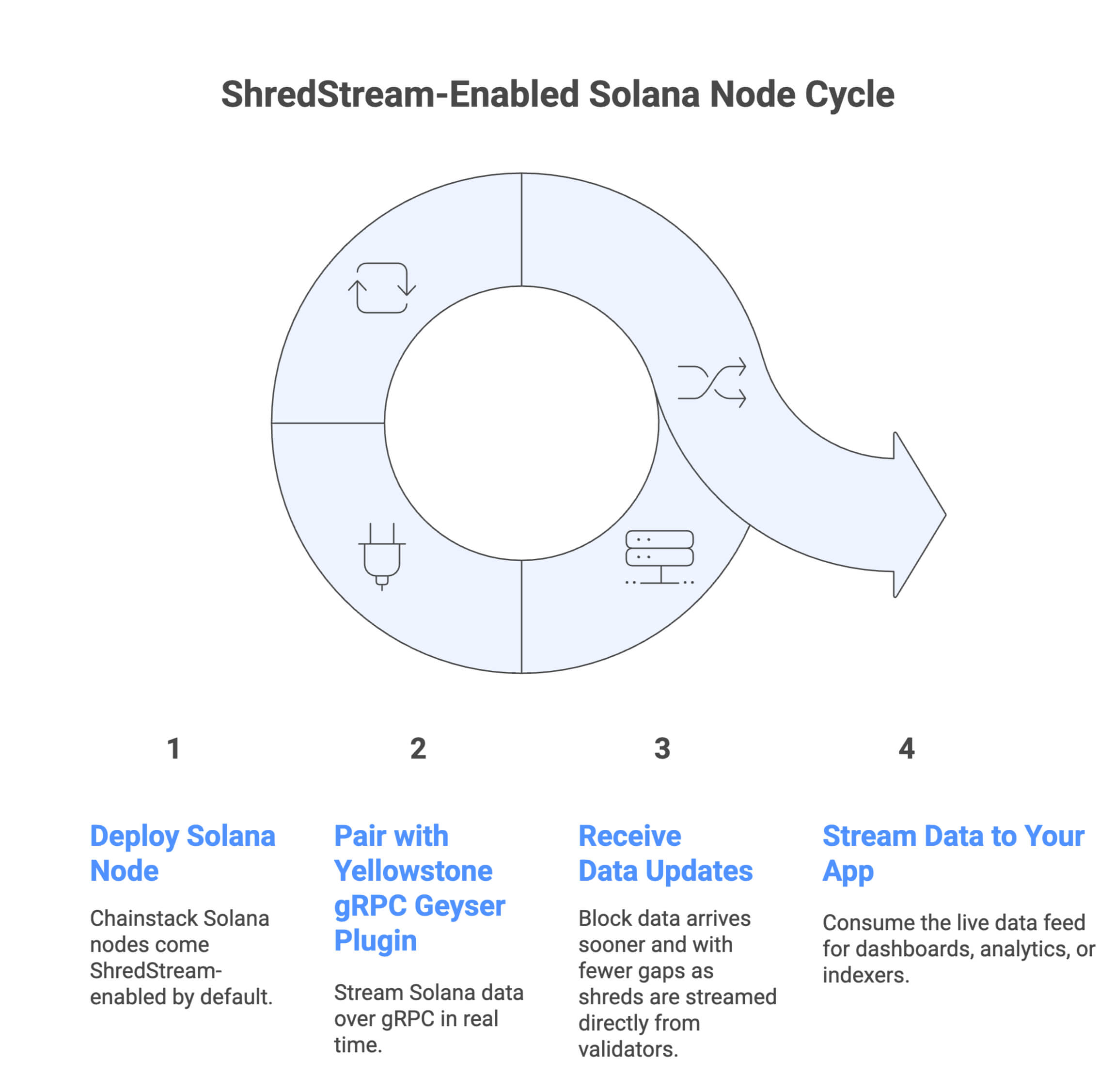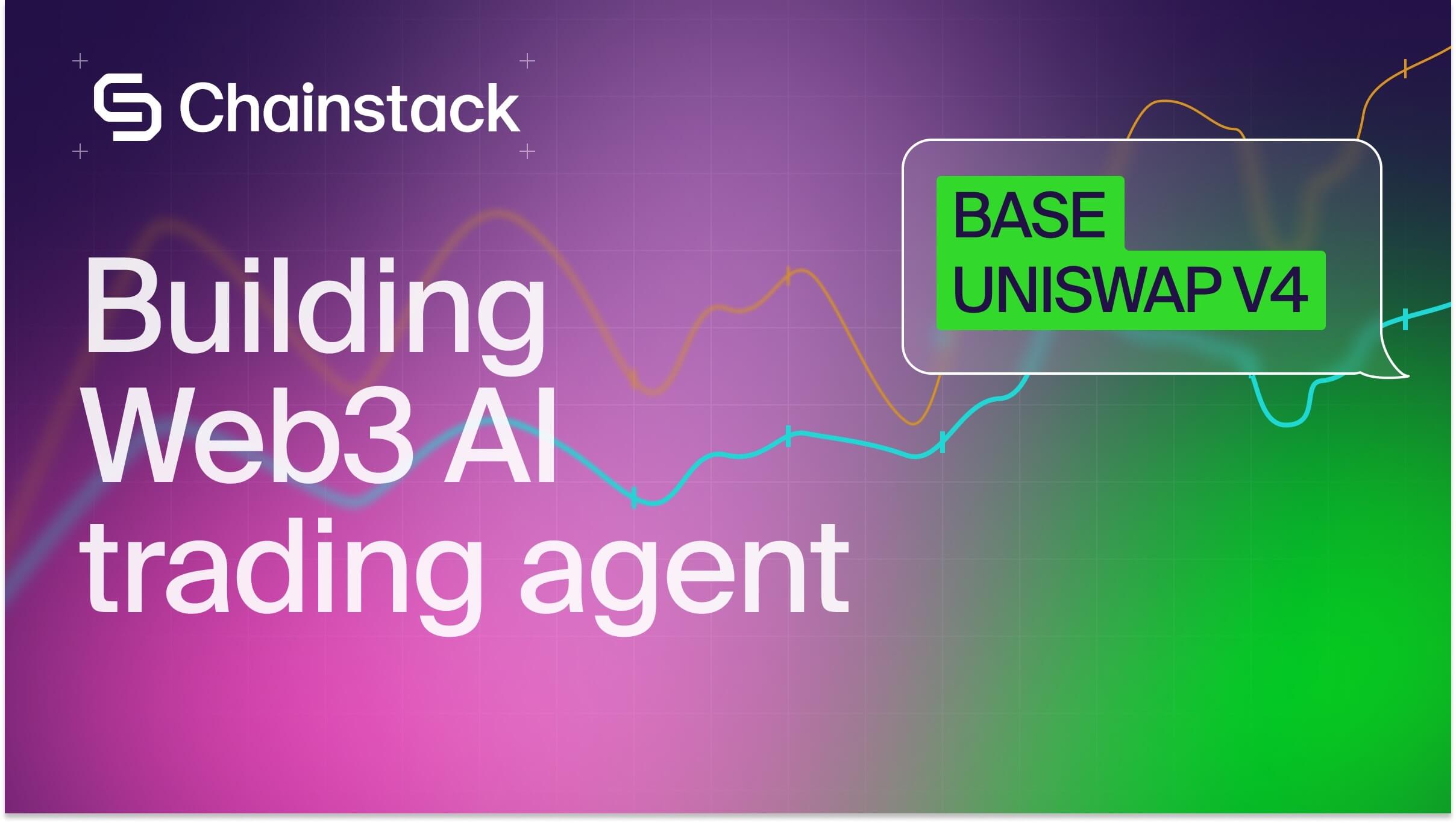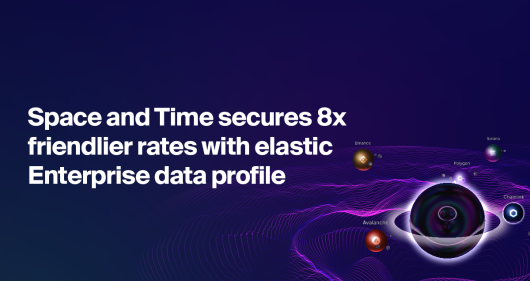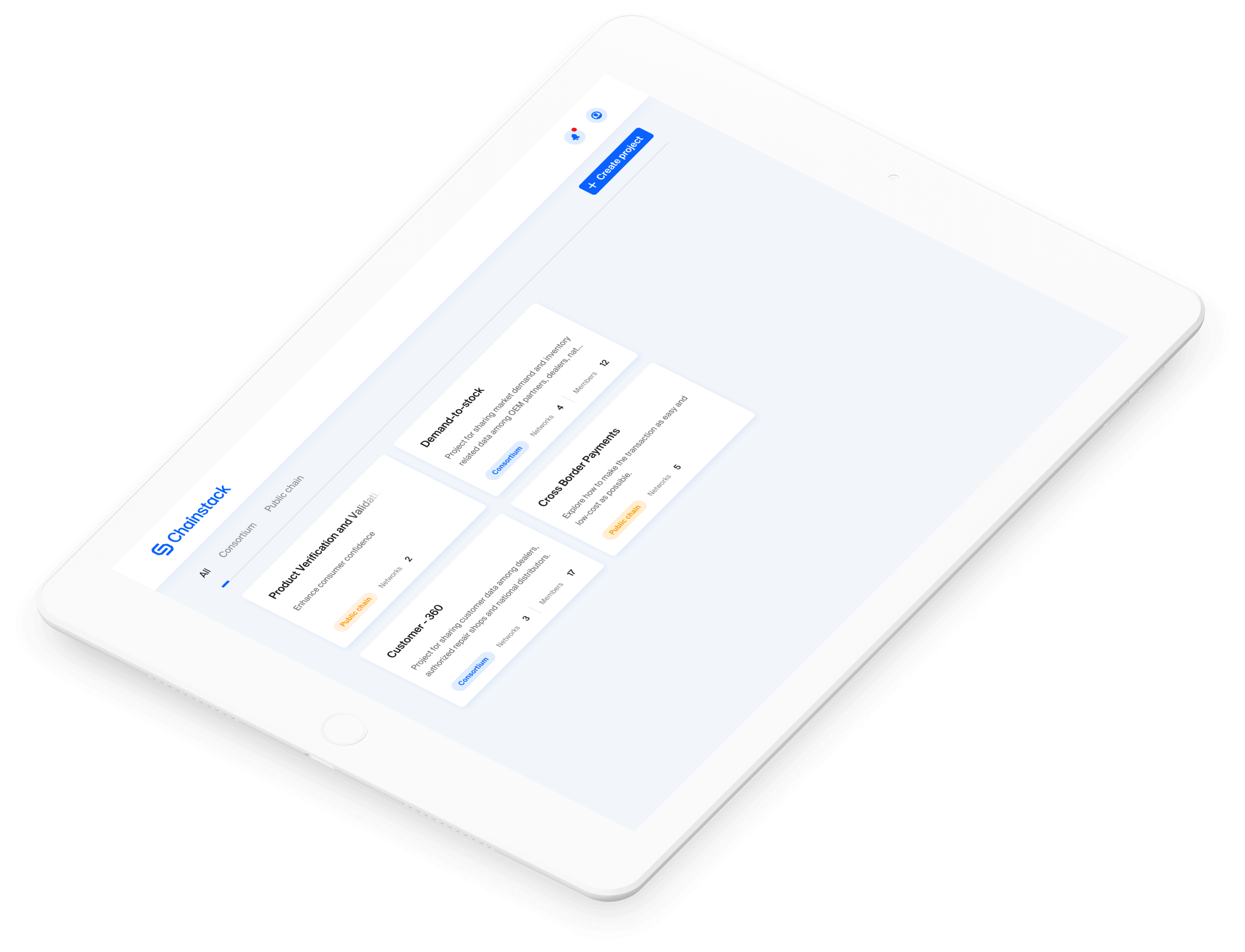How to improve Solana RPC latency with ShredStream
Solana runs on speed, and those who build on it chase every millisecond. ShredStream by Jito Labs brings block data closer to real time by streaming it through Jito’s Block Engine network from Solana validators instead of waiting for standard network propagation. This guide shows what it means for your stack and how to enable it on Chainstack.
Solana pushes data through the network faster than most systems can follow, yet anyone building latency-sensitive tools, even a few ms of delay still matters. Standard Solana RPC nodes receive block updates only after validators finish propagating them, which creates small but costly timing gaps.
ShredStream, built by Jito Labs, closes that gap by streaming shreds directly from the validators producing blocks. The result is steadier feeds, lower tail latency, and fewer missed slots. If you’ve been trying to get closer to real-time data or test the limits of your infrastructure, here’s how it works and how to enable it on Chainstack.
What is ShredStream?
To put it simply, ShredStream is a data feed that connects directly to Solana’s validators to deliver block data the moment it’s produced. Instead of waiting for information to travel through the network, it streams the individual shreds (the pieces that form each block) straight from the source.
In practice, it’s a faster pipeline between the validator generating the block and your RPC endpoint. Each shred arrives slightly earlier and with less timing variance, so your data feed reflects the chain’s state sooner and more consistently.
How you use it depends on your setup. If you run your own node, you can connect through the public ShredStream network, though configuring and maintaining it adds operational overhead. The simpler path is using an infrastructure provider that has already integrated it into their stack, like Chainstack.
Either setup gives you earlier block updates, more consistent timing, and fewer dropped slots when streaming Solana data.
How Solana shreds and block propagation work
To understand why ShredStream changes how your node performs, it helps to see how data usually travels through Solana.
Every block on Solana is split into small pieces called shreds. The validator produces the block and sends those shreds to other validators using a protocol called Turbine. Turbine works like a fanout tree: each validator forwards the shreds it receives to the next group in line until the entire network has a full copy of the block.
That process keeps the network decentralized and resilient, but it also introduces variability.
- Some validators are closer to the leader than others, so they receive shreds sooner.
- Network hops can create jitter, which means your RPC might see blocks a few hundred milliseconds after they’re produced.
- If a few shreds arrive late or out of order, your node can briefly lag behind or miss a slot entirely.
These delays don’t affect consensus, but they matter for builders who rely on real-time data. ShredStream bypasses that propagation tree by streaming the same shreds directly from the validators generating them. To put it simply, it just lets your RPC see the data as soon as it exists.
ShredStream-enabled Solana node vs non-ShredStream-enabled Solana node
Once you start using a ShredStream-enabled node, you notice the difference in how your data behaves:
| Type | non-ShredStream-enabled Solana node | ShredStream-enabled Solana node |
| Data path | Receives blocks after full network propagation | Streams shreds directly from validators as they’re produced |
| Latency | Average latency stable, tail latency high | Lower and more predictable tail latency |
| Consistency | Occasional jitter or missed slots | Continuous feed with even timing |
Pairing it up with the Yellowstone gRPC Geyser plugin
To make the most of your ShredStream-enabled Solana node, you’d want to pair ShredStream with the Yellowstone gRPC Geyser plugin.
The reason for that is simple: The plugin exposes Solana data, like transactions, accounts, and program updates, directly from the validator over gRPC. When your validator or RPC provider runs Yellowstone gRPC Geyser plugin on top of a ShredStream-backed feed, every update arrives sooner and with fewer gaps because the underlying shreds reach it first.

If you want to see how it works in practice, the plugin is available as an add-on on Chainstack. You can spin up a Solana node and start streaming data for as little as $49 a month, currently the most affordable managed setup on the market.
When to use ShredStream-enabled Solana Node
To put it in practice, we ran a short test on the same Solana GEN node—ten minutes with ShredStream, ten minutes without it. When we put it to the test, the quality of the data stream shifted noticeably, with the results showing 37% more slots in the optimal timing window and 3× fewer missed slots.
You see the biggest gains in setups where speed and consistency decide outcomes:
- High-frequency trading systems see steadier fills and fewer slow blocks.
- Liquidation and keeper bots trigger on time instead of a slot late.
- DeFi indexers and analytics pipelines run smoother with fewer backfills.
- Wallets, dashboards, and alerting tools show live updates without skipped blocks.
So with numbers like that, the takeaway is pretty clear: if you’re building anything that depends on live Solana data, you’ll want to run it through a ShredStream-enabled RPC.
How to access ShredStream-enabled node
If you want to start using ShredStream without setting up validators, you can do it directly using Chainstack. We’ve already wired ShredStream into our Yellowstone gRPC Geyser plugin, so you get the same real-time Solana feed Jito designed, streamed straight from validators, without any of the heavy lifting.
Here’s how to get it running:
- Log in to your Chainstack account (or create one if you don’t have one yet).
- Create a new project, or pick an existing one.
- Deploy a Solana Global Node.
- Open the node once it’s live.
- Go to Add-ons → Yellowstone gRPC Geyser Plugin → Install.
ShredStream is enabled by default inside the plugin, so as soon as the installation finishes, your streams are already pulling validator data in real time.
Wrapping up
ShredStream turns Solana data into a source you can trust slot after slot. With Chainstack, that capability is now part of your infrastructure, giving you validator-speed access to Solana data without touching validator code. Whether you’re running bots, analytics, or full-scale trading systems, it’s a direct path to reliable, low-latency infrastructure that scales with your workload.
Power-boost your project on Chainstack
- Discover how you can save thousands in infra costs every month with our unbeatable pricing on the most complete Web3 development platform.
- Input your workload and see how affordable Chainstack is compared to other RPC providers.
- Connect to Ethereum, Solana, BNB Smart Chain, Polygon, Arbitrum, Base, Optimism, Avalanche, TON, Ronin, Plasma, Hyperliquid, Scroll, Aptos, Fantom, Cronos, Gnosis Chain, Klaytn, Moonbeam, Celo, Aurora, Oasis Sapphire, Polygon zkEVM, and Bitcoin mainnet or testnets through an interface designed to help you get the job done.
- Fast access to blockchain archive data and gRPC streaming on Solana.
- To learn more about Chainstack, visit our Developer Portal or join our Telegram group.
- Are you in need of testnet tokens? Request some from our faucets. Sepolia faucet, Hoodi faucet, BNB faucet, zkSync faucet, Scroll faucet, Hyperliquid faucet.
Have you already explored what you can achieve with Chainstack? Get started for free today.
FAQ
ShredStream is a data feed built by Jito Labs that connects directly to Solana’s validators. It streams block data the moment it’s produced instead of waiting for it to travel through the wider network. The result is lower latency and more consistent Solana data for builders who rely on real-time updates.
No. ShredStream doesn’t alter Solana’s consensus or block production. It only changes how quickly your node receives the data once a block is produced.
Not at all. On Chainstack, ShredStream is already integrated into the nodes.
Projects that depend on real-time data: trading bots, liquidation systems, analytics dashboards, and DeFi indexers. Anything where timing or data freshness affects the outcome.
 Ethereum
Ethereum Solana
Solana TON
TON Base
Base BNB Smart Chain
BNB Smart Chain Hyperliquid
Hyperliquid Aptos
Aptos TRON
TRON Ronin
Ronin zkSync Era
zkSync Era Sonic
Sonic Polygon
Polygon Unichain
Unichain Gnosis Chain
Gnosis Chain Sui
Sui Avalanche Subnets
Avalanche Subnets Polygon CDK
Polygon CDK Starknet Appchains
Starknet Appchains zkSync Hyperchains
zkSync Hyperchains



























